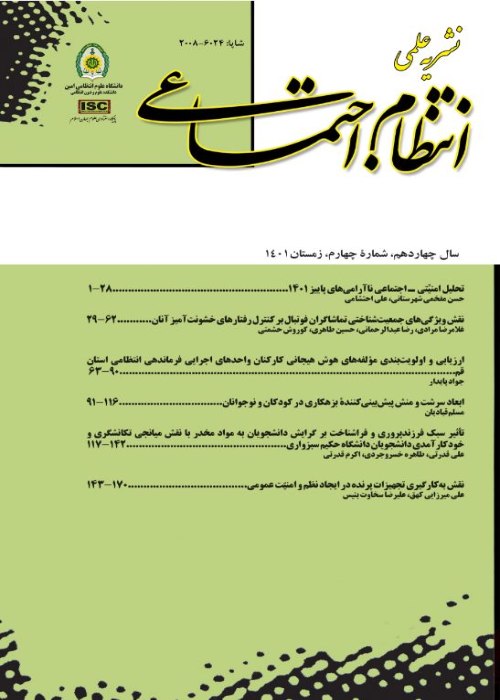The Effect of Situational Prevention Methods in Reducing the Crimes among Qazvin Mehr Housing Migrants
With the increase in the number of criminal behaviors in Qazvin Mehr Housing, especially the types of theft, strife and conflict and social corruption, it is necessary to prevent the growth of this type of crime with a preventive approach. The purpose of this study is to identify situational prevention methods in reducing the crimes among Qazvin Mehr Housing migrants.
In terms of its objectives this study is of an applied research type and in terms of its method it is considered as a descriptive-analytical research. The statistical population consists of law enforcement experts (55 individuals) and residents of Mehr Housing Complexes (30,000 individuals). 430 samples (48 experts and 375 residents) were selected using Morgan Table. The data collection tool was a researcher-made questionnaire whose validity was confirmed through content validity and its reliability was confirmed by Cronbach's alpha coefficient (0.98) prior to the study. Finally, the data were analyzed using SPSS software and statistical tests of analysis of variance and Pearson correlations.
The findings of the research, while confirming and in line with the findings of the research background, show that according to the values of standardized regression coefficients, the variable of increasing the threshold during crime with a standardized coefficient of β = 0.271 has the greatest effect on the dependent variable of crime prevention among the immigrants of Mehr Housing. On the other hand, the variables of using supervisory technologies and reducing the chances of committing a crime and reducing the success of a crime are in the next ranks in terms of the effectiveness, respectively.
The results show that the multiple correlation coefficient of R = 0.788, the intensity of the relationship between criterion and predictor variables was very strong and effective at the same time. The square of multiple correlation coefficient = 0.620 also indicates that the predictor variables (increasing the risk threshold of committing a crime, increasing the threshold during the crime, increasing the risk of identifying and arresting criminals, using supervisory technologies and reducing opportunities for crime, and reducing the success rate of crime), explain 62% of the changes in the criterion variable (crime prevention). Therefore, it is possible to reduce crime in these areas by preventive measures (while reducing I. R. I. Police costs and behavioral tensions between the police and Mehr Housing migrants), especially supervisory technologies and reducing crime opportunities and reducing the success of crime.
- حق عضویت دریافتی صرف حمایت از نشریات عضو و نگهداری، تکمیل و توسعه مگیران میشود.
- پرداخت حق اشتراک و دانلود مقالات اجازه بازنشر آن در سایر رسانههای چاپی و دیجیتال را به کاربر نمیدهد.



